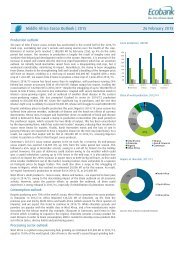www.ebook777.com
Make_Getting_Started_with_Processing_Second_Edition
Make_Getting_Started_with_Processing_Second_Edition
Create successful ePaper yourself
Turn your PDF publications into a flip-book with our unique Google optimized e-Paper software.
Figure 12-1. Tables are grids of cells. Rows are the horizontal<br />
elements and columns are vertical. Data can be read from individual<br />
cells, rows, and columns.<br />
Table data is often stored in plain-text files with columns using<br />
commas or the tab character. A comma-separated values file is<br />
abbreviated as CSV and uses the file extension .csv. When tabs<br />
are used, the extension .tsv is sometimes used.<br />
To load a CSV or TSV file, first place it into a sketch’s data folder<br />
as described at the beginning of Chapter 7, and then use the<br />
loadTable() function to get the data and place it into an object<br />
made from the Table class.<br />
Only the first few lines of each data set are shown in<br />
the following examples. If you’re manually typing the<br />
code, you’ll need the entire .csv, .json, or .tsv file to<br />
replicate the visualizations shown in the figures. You<br />
can get them from an example sketch’s data folder<br />
(see “Examples and Reference” on page 11).<br />
The data for the next example is a simplified version of Boston<br />
Red Sox player David Ortiz’s batting statistics from 1997 to<br />
2014. From left to right, it lists the year, number of home runs,<br />
runs batted in (RBIs), and batting average. When opened in a<br />
text editor, the first five lines of the file looks like this:<br />
1997,1,6,0.327<br />
1998,9,46,0.277<br />
1999,0,0,0<br />
Data 167



